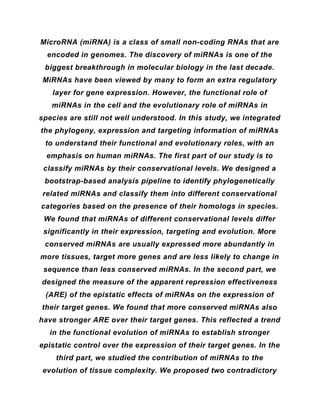
Role of miRNAs in Gene Regulation and Evolution
- 1. MicroRNA (miRNA) is a class of small non-coding RNAs that are encoded in genomes. The discovery of miRNAs is one of the biggest breakthrough in molecular biology in the last decade. MiRNAs have been viewed by many to form an extra regulatory layer for gene expression. However, the functional role of miRNAs in the cell and the evolutionary role of miRNAs in species are still not well understood. In this study, we integrated the phylogeny, expression and targeting information of miRNAs to understand their functional and evolutionary roles, with an emphasis on human miRNAs. The first part of our study is to classify miRNAs by their conservational levels. We designed a bootstrap-based analysis pipeline to identify phylogenetically related miRNAs and classify them into different conservational categories based on the presence of their homologs in species. We found that miRNAs of different conservational levels differ significantly in their expression, targeting and evolution. More conserved miRNAs are usually expressed more abundantly in more tissues, target more genes and are less likely to change in sequence than less conserved miRNAs. In the second part, we designed the measure of the apparent repression effectiveness (ARE) of the epistatic effects of miRNAs on the expression of their target genes. We found that more conserved miRNAs also have stronger ARE over their target genes. This reflected a trend in the functional evolution of miRNAs to establish stronger epistatic control over the expression of their target genes. In the third part, we studied the contribution of miRNAs to the evolution of tissue complexity. We proposed two contradictory
- 2. models differentiating the possible mechanisms of the involvement of miRNAs in tissue complexity and evaluated the models with phylogeny, expression and targeting data of human genes and miRNAs. Our study showed that miRNAs are likely to have important roles in the initial establishment of new tissue identities. However, miRNA-mediated regulations may be replaced gradually by endogenous mechanisms in a process we defined as "burn-in." As the result, in most current tissues, miRNAs may just have secondary maintenance roles in gene regulation. In the fourth part, we studied the evolvability of miRNAs by simulated evolution. It is much easier to predict miRNA targets by sequence than to predict protein-protein interaction by sequence. In this regard, miRNAs can be used as model systems for hard evolution problems. We explored the fitness space of miRNA sequences defined by the expression profiles of potential target genes. Our results suggested that the balance of a "selfish" force driving miRNAs to target more genes and a selective force against targeting highly expressed or vital genes may result in the exhaustion of evolvability of miRNAs in evolution
